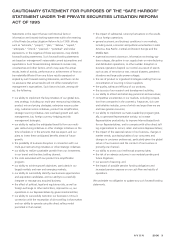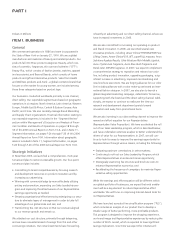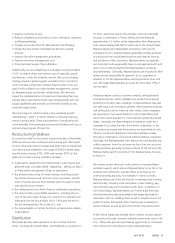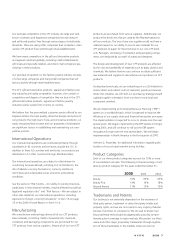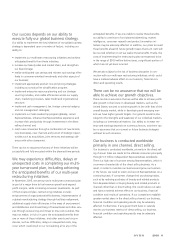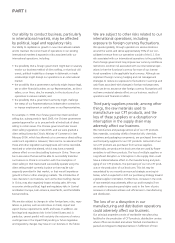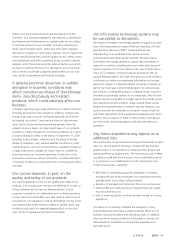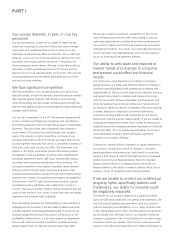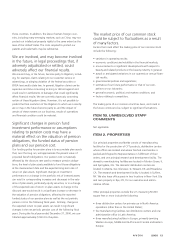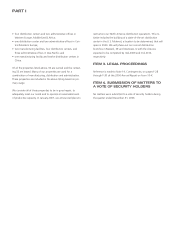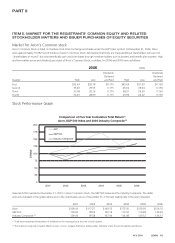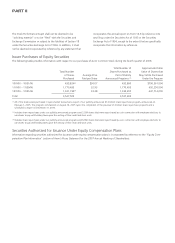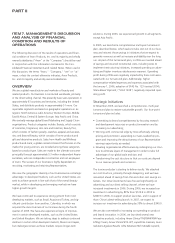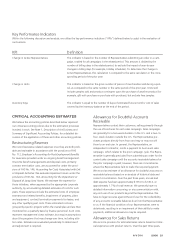Avon 2006 Annual Report Download - page 18
Download and view the complete annual report
Please find page 18 of the 2006 Avon annual report below. You can navigate through the pages in the report by either clicking on the pages listed below, or by using the keyword search tool below to find specific information within the annual report.PART I
Our success depends, in part, on our key
personnel.
Our success depends, in part, on our ability to retain our key
personnel, including our executive officers and senior manage-
ment team. The unexpected loss of one or more of our key
employees could adversely affect our business. Our success also
depends, in part, on our continuing ability to identify, hire, train
and retain other highly qualified personnel. Competition for
these employees can be intense. We may not be able to attract,
assimilate or retain qualified personnel in the future, and our
failure to do so could adversely affect our business. This risk may
be exacerbated by the uncertainties associated with our multi-
year restructuring initiatives.
We face significant competition.
We face competition from competing products in each of our
lines of business, in both the domestic and international markets.
We compete against products sold directly to consumers by
other direct-selling and direct sales companies and through the
Internet, and against products sold through the mass market and
prestige retail channels.
Our principal competitors in the CFT industry are large and well-
known cosmetics and fragrances companies that manufacture
and sell broad product lines through various types of retail estab-
lishments. There are many other companies that compete in
more narrow CFT product lines sold through retail establish-
ments. This industry is highly competitive, and some of our
principal competitors in the CFT industry are larger than we are
and have greater resources than we do. Competitive activities on
their part could cause our sales to suffer. We have many com-
petitors in the highly competitive gift and decorative products
and apparel industries globally, including retail establishments,
principally department stores, gift shops and specialty retailers,
and direct-mail companies specializing in these products. Our
principal competition in the highly competitive fashion jewelry
industry consists of a few large companies and many small
companies that sell fashion jewelry through retail establishments.
However, the number of competitors and degree of competition
that we face in the CFT, gift and decorative products, apparel
and fashion jewelry industries varies widely from country to
country. There are a number of direct-selling companies that sell
product lines similar to ours, some of which also have worldwide
operations and compete with us globally.
If our advertising, promotional, merchandising or other marketing
strategies are not successful, if we are unable to deliver new prod-
ucts that represent technological breakthroughs, if we do not suc-
cessfully manage the timing of new product introductions or the
profitability of these efforts, or if for other reasons our Representa-
tives or end customers perceive competitors’ products as having
greater appeal, then our sales and financial results may suffer.
We are also subject to significant competition for the recruit-
ment of Representatives from other direct selling or network
marketing organizations, including those that market personal
care products, dietary and nutritional supplements and weight
management products. As a result, it is continually necessary to
recruit and retain new Representatives and if we are unable to
do so our business will be adversely affected.
Our ability to anticipate and respond to
market trends and changes in consumer
preferences could affect our financial
results.
Our continued success depends on our ability to anticipate,
gauge and react in a timely and effective manner to changes in
consumer spending patterns and preferences for beauty and
related products. We must continually work to develop, produce
and market new products, maintain and enhance the recog-
nition of our brands, achieve a favorable mix of products, and
refine our approach as to how and where we market and sell
our products. While we devote considerable effort and resources
to shape, analyze and respond to consumer preferences,
consumer spending patterns and preferences cannot be pre-
dicted with certainty and can change rapidly. If we are unable to
anticipate and respond to trends in the market for beauty and
related products and changing consumer demands, our financial
results will suffer. This risk may be exacerbated by our product
line simplification program, which will lead to significant
changes to our product offerings.
Furthermore, material shifts or decreases in market demand for
our products, including as a result of changes in consumer
spending patterns and preferences, could result in us carrying
inventory that cannot be sold at anticipated prices or increased
product returns by our Representatives. Failure to maintain
proper inventory levels or increased product returns by our
Representatives could result in a material adverse effect on our
business, results of operations and financial condition.
If we are unable to protect our intellectual
property rights, specifically patents and
trademarks, our ability to compete could
be negatively impacted.
The market for our products depends to a significant extent
upon the value associated with our patents and trademarks. We
own the material patents and trademarks used in connection
with the marketing and distribution of our major products both
in the United States and in other countries where such products
are principally sold. Although most of our material intellectual
property is registered in the United States and in certain foreign
countries in which we operate, there can be no assurance with
respect to the rights associated with such intellectual property in



